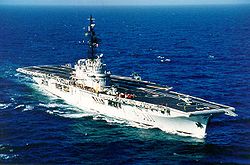NAeL Minas Gerais
|
||||||||||||||||||||||||
|
||||||||||||||||||||||||
|
||||||||||||||||||||||||
|
||||||||||||||||||||||||
The NAeL Minas Gerais was a light aircraft carrier for the Brazilian Navy . It was the flagship of the Brazilian Navy from 1960 to 2001 .
The ship was created as HMS Vengeance (ID: R71) of the Colossus class for the British Royal Navy and was loaned to the Royal Australian Navy (RAN) from 1952 to 1955 .
history
The keel-laying of the later Vengeance took place on November 16, 1942 at the Swan, Hunter & Wigham Richardson shipyard in Wallsend . The new construction of a light girder with hull number 1699 was launched on February 23, 1944 as the fourth ship of the Canopus class and was named Vengeance . The aircraft carrier was the 7th ship in the Royal Navy to receive this name, which was last given a liner of the older Canopus class in 1899 and ran until it was demolished in 1921. On January 15, 1945, the ship was finally completed.
Previous working hours
In January 1945 in the service of the Royal Navy, the light carrier was assigned to the British Pacific Fleet (BEF). Together with the sister ships Colossus , Glory and Venerable , the carrier moved through the Mediterranean and the Indian Ocean to the remaining theaters of war, where they arrived in August 1945. The first use of the Vengeance , which had the 812 squadron with Fairey Barracuda II and the 1850 squadron with Chance Vought Corsair IV on board, was to take place during the reconquest of Malaysia. The surrender of Japan prevented further combat operations and the carrier ran via Singapore to Hong Kong , which was reoccupied by the British from September 1st. In addition to her, the porters Venerable and Indomitable also belonged to the fleet association deployed there . In the period that followed, the carrier was used to transport liberated prisoners of war and civilian internees. The ship remained with the Pacific Fleet and, in addition to serving as a porter, was also used to transport supplies, equipment, personnel and mail between bases in Japan, Hong Kong, Singapore and Australia and visited Hiroshima in early 1946 . In the summer the carrier was released from the BEF and left Trincomalee in July 1946 with the frigates Loch Eck and Loch Craggie . The ships reached Spithead on August 10, 1946. Between 1947 and 1950 the Vengeance was part of the Home Fleet and was used for experiments with helicopters in the cold conditions of the Arctic.
On November 13, 1952, the RAN took over the carrier on loan for three years to bridge the time until the completion of the Melbourne ex HMS Majestic . The Vengeance aircraft group at the RAN consisted of twelve Sea Fury FB.11 fighter-bombers and Firefly FR.4 / AS.6 reconnaissance / anti- submarine aircraft and three Sycamore Mk.50 helicopters . In August 1955, the carrier was returned to the Royal Navy and put on the sale list. In December 1956 it was sold to Brazil.
With the Brazilian Navy
At the end of 1956, Brazil acquired the ship from the Royal Navy, renamed it Minas Gerais after the Brazilian state of the same name, Minas Gerais, and immediately sent it to a Dutch shipyard where modifications and modernizations were carried out.
The acquisition of the ship sparked a serious dispute between the country's navy and air force (FAB) . The Navy claimed control of the aircraft stationed on the carrier, even against violent protests from the Air Force. For this reason, the 1 ° Grupo de Aviação Embarcada da FAB was launched on February 6, 1957 . Under the leadership of the FAB, it was supposed to provide the Minas Gerais aircraft squadrons . This group was divided into two squadrons: a fighter squadron and one for patrol flights, both with machines of the type Grumman S-2 . However, the problem persisted for the following governments. It was not until 1964 that President Humberto Castelo Branco assured the FAB that it had full power of disposal over the stationed aircraft.
From 1960 the ship was incorporated into the Brazilian fleet and navigated primarily along the coast of the country. Despite the modernizations that were carried out, the turbine output was only sufficient for about 20 kn . That is three to four knots less than would have been necessary for more modern aircraft. Therefore, the Minas Gerais was decommissioned on October 9, 2001 and replaced by the NAe São Paulo .
Final fate of the Minas Gerais
In 2002 the Minas Gerais was auctioned. Most of the twelve bidders stated that they would scrap the ship and process the steel further. A representative of the British non-governmental organization Friends of the HMS Vengeance wanted to restore the WWII ship and exhibit it in a museum.
The ship was eventually sold to an event company in Shanghai for $ 2 million . A Chinese museum was supported by the fact that the surrender of the Imperial Japanese troops stationed there had been signed on the ship after the Japanese occupation of Hong Kong . However, there was also speculation about a possible Chinese carrier program, especially since the aircraft carrier was not overhauled until 1998. According to Friends of the HMS Vengeance , the Chinese purchase failed due to financing problems.
The Minas Gerais was towed to India in 2004 and scrapped in Alang .
See also
Web links
- GlobalDefence.net about a possible Chinese carrier program
- The Last Farewell hms-vengeance.co.uk, accessed April 17, 2020 - Pictures from the last trip to India in April 2004 in February 2004
